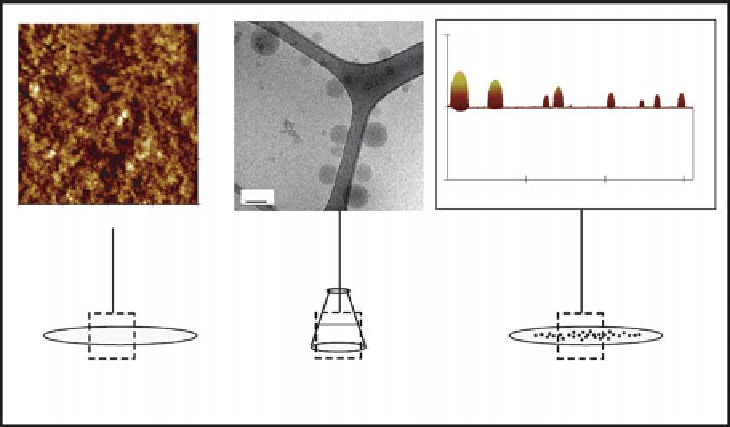Biomedical Engineering Reference
In-Depth Information
1.00
0.75
0.50
x
z
2.000
m
m/div
500.000 nm/div
0.25
6
m
m
2
4
100 nm
0
0
0.25
0.50
0.75
1.00
m
m
PECs in solution
anionic PECs adsorbed
lignin-coated qcm crystal
Figure7.15
Schematicillustrationoftheapperanceof(a)theligninfilmonaQCM-Dcrystal
imagedbyafm, (b) PECs in solutionas caught bycryo-TEM, and (c) anionicPECs adsorbed
onalignin-coatedqcmcrystal imagedbyafm. AdaptedwithpermissionfromNorgrenetal.
(2007).Copyright(2007),AmericanChemicalSociety.
Figure 7.15. This showed that polyelectrolyte adsorption to lignin can be through both
ionic and nonionic interactions.
A subsequent study to investigate the possibility of nonionic interaction was under-
taken with the same type of surfaces however with this time, a strong polyelectrolyte
whose charge density is effectively constant with pH, poly(diallyldimethylammonium
chloride) (PDADMAC) (Notley and Norgren 2008). In that study, it was shown that the
adsorption to the kraft lignin film agreed well with the Scheutjens-Fleer theory (Fleer
et al
. 1993). The adsorbed amount decreased as the ionic strength of the adsorbing
polymer solution was increased. However, because of the problems surrounding the sta-
bility of the films at salt concentrations greater than 0.1 mM, no definitive conclusions
could be made on the likelihood of nonionic interactions.
Tammelin
et al
. have used model lignin films to investigate the interaction of hemi-
cellulose and extractives with lignin (Tammelin
et al
. 2006 and 2007). In their studies,
a milled wood lignin from Norway Spruce was used as the raw lignin material and was
spin-coated onto polystyrene coated quartz crystals resulting in smooth films suitable for
measuring the adsorption of hemi-cellulose and extractives. The adsorbed amount of
hemi-cellulose onto the lignin surface was quite low. Furthermore, it was observed that
the layer conformation was soft and highly viscoelastic for hemi-cellulose isolated from
unbleached mechanical pulp but was rigid for material isolated from bleached pulp.
The observed difference was ascribed to the increased anionic charge density for the
hemi-cellulose from the bleached mechanical pulp which leads to flatter conformation
of the polymer at the interface in agreement with theories describing the adsorption of
highly charged polymers to solid surfaces.

Search WWH ::

Custom Search